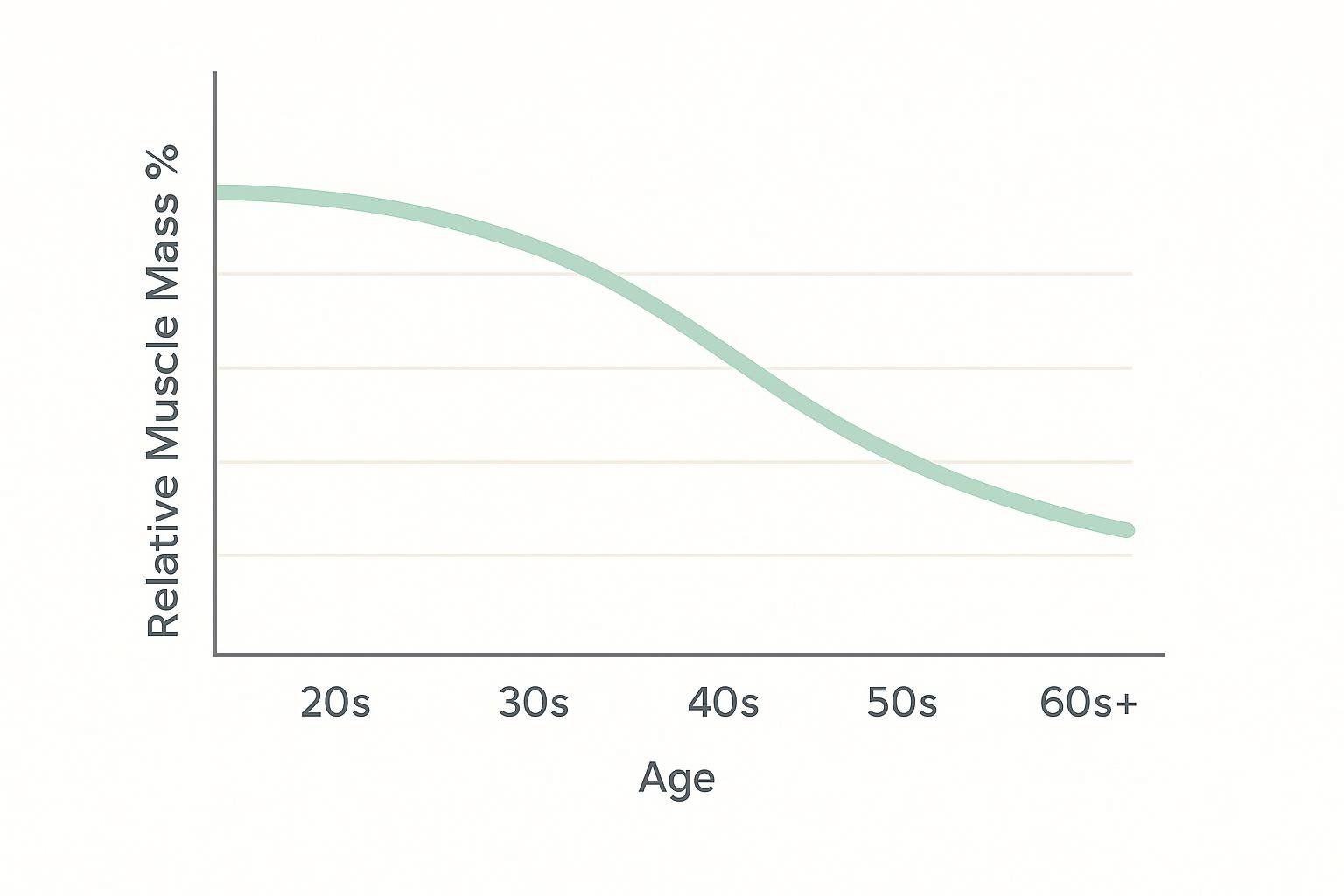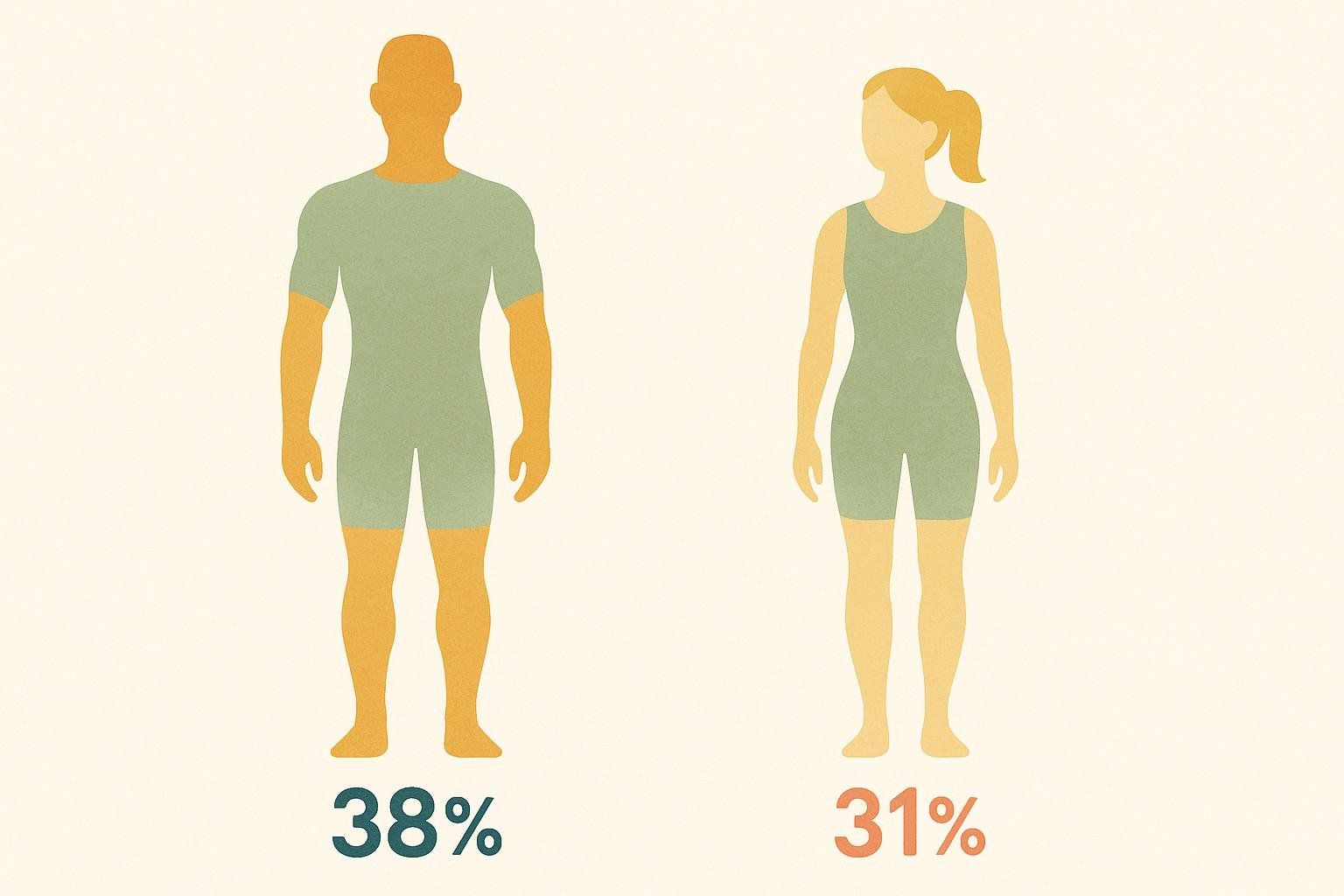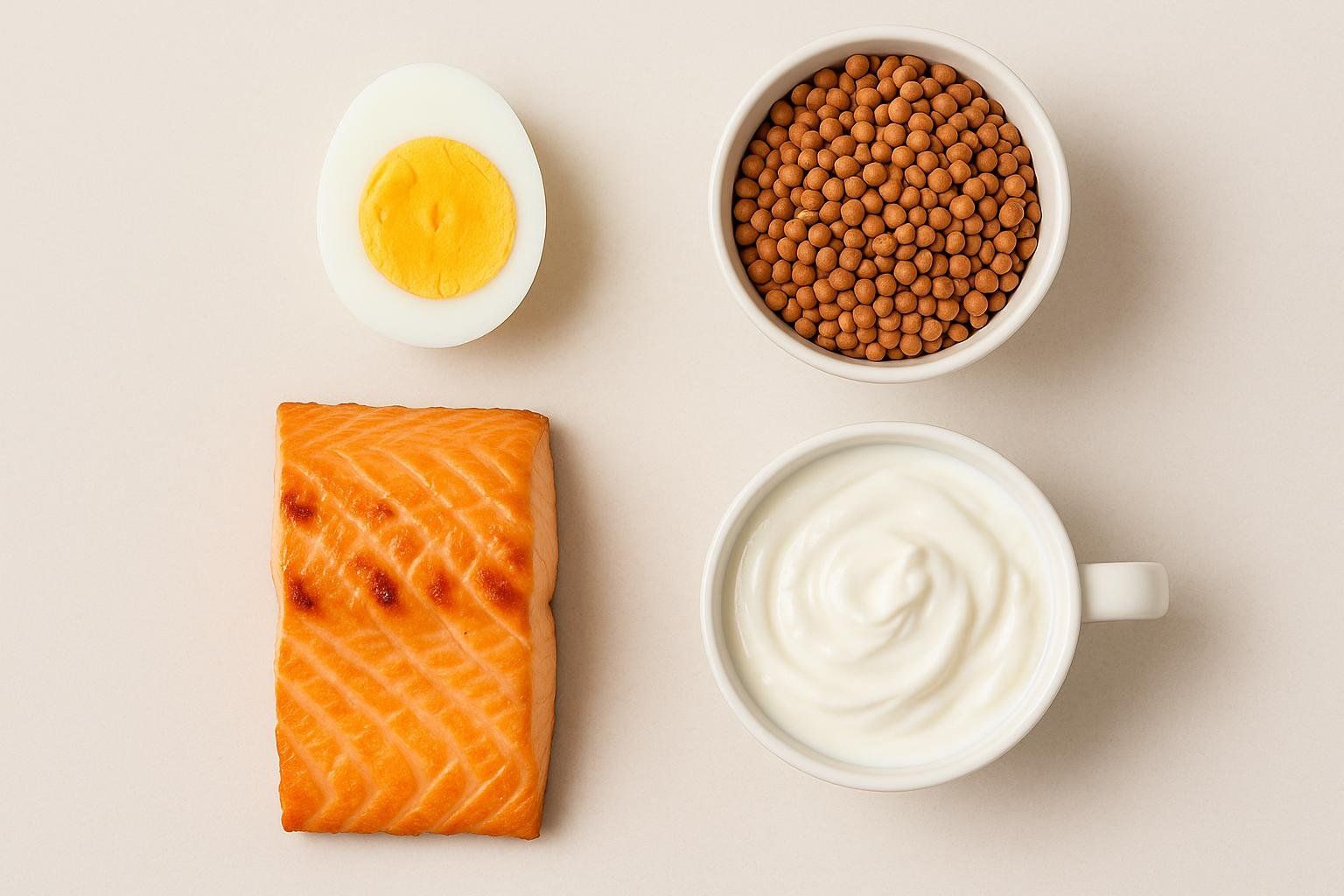Healthy Muscle Mass Percentage for Women by Age

What is a Healthy Muscle Mass Percentage for Women? (Data by Age)
If you've recently stepped on a smart scale or gotten a body composition test, you might be staring at a muscle mass percentage wondering, "Is this normal?" You're not alone. As more women turn to strength training and body composition tracking, understanding what constitutes healthy muscle mass has become crucial for setting realistic goals and maintaining long-term health.
The short answer: healthy muscle mass percentages for women typically range from 27-33% depending on age. Research analyzing 18,625 adults shows that while absolute muscle mass peaks around age 40-49, muscle mass as a percentage of body weight follows an age-related decline, with women experiencing approximately 5.7% reduction per decade after age 50. But like most health metrics, the full picture is more nuanced—and more interesting.
This guide breaks down the science behind female muscle mass, provides age-specific benchmarks, and explains how to use this information to optimize your health and fitness journey.
Understanding Muscle Mass Percentages: The Foundation
When we talk about muscle mass percentage, we're typically referring to skeletal muscle mass—the muscles that move your bones and joints. This is different from total lean mass, which includes muscles, organs, bones, and water. This measurement varies significantly by gender, age, and fitness level.
For women, muscle mass serves critical functions beyond appearance:

- Metabolic engine: Muscle tissue burns approximately 4.5-7 calories per pound per day at rest, contributing significantly to your daily calorie expenditure
- Strength and function: Adequate muscle mass prevents falls, maintains independence, and supports daily activities
- Bone health: Resistance exercise that builds muscle also strengthens bones
- Hormonal health: Muscle tissue plays a role in maintaining healthy blood sugar and hormone levels
Common Misconceptions About Women and Muscle
Many women worry that building muscle will make them look "bulky." This fear is largely unfounded due to biological differences. Women naturally have lower testosterone levels than men, which limits the extent of muscle growth. Research analyzing resistance training responses found that males and females adapt to training with similar effect sizes for muscle hypertrophy, though women start from a lower baseline and have different growth ceilings due to hormonal differences.
Average Muscle Mass for Women: Data by Age
Recent research provides clear benchmarks for healthy muscle mass across different life stages. The most comprehensive data comes from studies analyzing thousands of participants to determine the average muscle mass for female individuals across age groups:
| Age Group | Higher Range | Typical Range | Lower Range |
|---|---|---|---|
| 18-39 years | 32-33%+ | 29-31% | Below 29% |
| 40-49 years | 31-33%+ | 28-30% | Below 28% |
| 50-65 years | 30-31%+ | 27-29% | Below 27% |
| 65+ years | 28-30%+ | 25-27% | Below 25% |
Note: These categories are editorial interpretations derived from the average values in the cited clinical study of 18,625 adults. They are intended as general guidelines, not clinical definitions. Always consult a healthcare provider for personalized advice.

The Age-Related Decline Pattern
The comprehensive study of Brazilian adults revealed important patterns about how muscle mass changes throughout women's lives. While absolute muscle mass (total kilograms) reaches its peak between ages 40-49, relative muscle mass as a percentage of body weight shows a different pattern, with gradual decline beginning earlier and accelerating after age 50, at approximately 5.7% per decade.
This distinction is crucial for understanding your own measurements. The absolute peak in midlife reflects accumulated muscle building over decades, but relative muscle mass percentage—what most body composition tests report—follows the expected age-related decline pattern.
The Gender Gap: Women vs. Men

A comprehensive study using magnetic resonance imaging to analyze 468 adults found significant differences between men and women. Men had 38.4% muscle mass relative to body weight compared to women's 30.6%—a difference that persists across age groups but becomes more pronounced in the upper body.
Interestingly, this difference is not necessarily disadvantageous. Women's lower muscle mass percentage doesn't translate to inferior performance when adjusted for body size, and women often show greater relative strength gains during training.
Elite Athletes vs. Average Women: The Performance Spectrum
For women who train seriously or compete in strength sports, muscle mass percentages can be significantly higher than population averages.
Female Athletes: Breaking the Mold

Research on female athletes reveals dramatically higher muscle mass levels compared to sedentary women. A study examining 45 female athletes found that athletes had average fat-free mass (FFM) of approximately 52.2 kg compared to 45.0 kg in the control group. While the exact muscle mass percentages varied based on body size, the research showed that female athletes possessed significantly greater muscle mass than controls across all measurements.
The study notes that while specific percentage ranges for elite athletes aren't definitively established, competitive female athletes typically achieve muscle mass values substantially above the general population ranges (27-33%), though individual results depend heavily on sport type, training history, and body composition.
Sport-Specific Variations
Different sports produce different muscle mass profiles:
- Powerlifters and weightlifters: Highest absolute muscle mass
- Marathon runners: Lower muscle mass percentages, optimized for endurance
- CrossFit athletes: Balanced muscle development across multiple movement patterns
- Bodybuilders: High muscle mass with very low body fat percentages
These variations highlight that optimal muscle mass depends heavily on your specific goals and activities.
How Muscle Mass Changes with Age: The Sarcopenia Factor
Understanding age-related muscle loss—termed sarcopenia—is crucial for long-term health planning. The process begins earlier than most people realize.
The Timeline of Muscle Loss
Research using magnetic resonance imaging shows that relative skeletal muscle mass begins declining in the third decade of life, though the changes are initially subtle. Significant absolute muscle mass loss doesn't become apparent until after age 50, when the decline accelerates.
For women specifically, the 2023 PMC study found that muscle mass decline accelerates at 5.7% per decade from the sixth decade of life onwards. This timeline coincides with hormonal changes, particularly declining estrogen levels during and after menopause.
Why Women Are at Higher Risk
Women face unique challenges regarding age-related muscle loss:
- Lower starting point: Beginning with less muscle mass means losing the same percentage results in greater functional impact
- Hormonal changes: Menopause brings significant hormonal shifts that can accelerate muscle loss
- Lifestyle factors: Traditionally, fewer women have engaged in regular resistance training, though this is changing
The good news? Sarcopenia is largely preventable and reversible through targeted interventions. For a comprehensive guide to understanding and preventing age-related muscle loss, see our complete guide to sarcopenia prevention and management.
Measuring Your Muscle Mass: Methods and Accuracy
Not all muscle mass measurements are created equal. Understanding the different methods—and their limitations—is crucial for interpreting your results.
DEXA Scan: The Gold Standard
Dual-energy X-ray absorptiometry (DEXA) represents the most accurate and accessible method for measuring body composition. DEXA scans can measure skeletal muscle mass and provide detailed regional analysis while tracking changes over time.
DEXA advantages include:
- High accuracy: Closely correlates with MRI measurements
- Comprehensive data: Measures muscle, fat, and bone density simultaneously
- Regional analysis: Shows exactly where you're gaining or losing muscle
- Low radiation: About the same exposure as eating several bananas
- Affordability: Much less expensive than MRI or CT scans
Bioimpedance Analysis (BIA): Convenient but Variable
Many smart scales and gym machines use bioimpedance to estimate muscle mass. While convenient, BIA has significant limitations. Studies comparing BIA to DEXA found that BIA tends to overestimate muscle mass, particularly in people with lower BMIs.
BIA results can be affected by:
- Hydration levels
- Food consumption
- Exercise timing
- Menstrual cycle phase
- Room temperature
Other Methods: Research Grade
MRI and CT scans provide the most precise muscle measurements but are expensive and typically reserved for research settings. These methods serve as the reference standard for validating other techniques.
Individual Factors That Affect Your Muscle Mass
Several factors can influence your muscle mass percentage beyond age:
Height and Frame Size: Taller women often have different muscle mass distributions compared to shorter women.
Genetics: Some people naturally build and maintain muscle more easily due to genetic variations in muscle fiber types, hormone sensitivity, and metabolism.
Activity History: Your lifetime history of physical activity significantly impacts current muscle mass levels.
Health Status: Certain medical conditions, medications, and hormonal imbalances can affect muscle mass.
When to Be Concerned
Consider consulting with a healthcare provider if:
- Your muscle mass percentage falls well below typical ranges for your age
- You notice a rapid and unintentional loss of muscle mass or strength
- You're experiencing symptoms like unusual fatigue, weakness, or frequent falls
- You have risk factors for sarcopenia (sedentary lifestyle, poor nutrition, chronic illness)
Building and Maintaining Healthy Muscle Mass
Regardless of your current muscle mass level, you can take steps to optimize and maintain it throughout life.
Progressive Resistance Training: The Foundation
Research consistently shows that progressive resistance training is the most effective intervention for building and maintaining muscle mass in women. The key principles:
- Frequency: Aim for 2-3 resistance training sessions per week, targeting major muscle groups
- Progressive Overload: Gradually increase weight, repetitions, or sets over time to continually challenge your muscles
- Compound Movements: Focus on exercises that work multiple muscle groups simultaneously (squats, deadlifts, rows, presses)
- Consistency: Long-term adherence matters more than perfect workouts
For detailed guidance on getting started with resistance training, see our comprehensive guide to female muscle building.
Protein: The Building Block

Adequate protein intake is crucial for muscle maintenance and growth. The International Society of Sports Nutrition recommends that individuals engaged in regular exercise training consume between 1.4–2.0 g/kg/day of protein, which is significantly higher than the basic RDA for sedentary adults.
For active women specifically:
- Regular exercisers: 1.4-1.6 grams per kilogram of body weight daily
- Highly active athletes: 1.6-2.0 grams per kilogram of body weight daily
- Distribution: Aim for 20-30 grams of protein per meal to optimize muscle protein synthesis
Quality protein sources include lean meats, fish, eggs, dairy, legumes, and high-quality protein supplements.
Hormonal Considerations
Women's hormonal profiles significantly impact muscle development:
Estrogen: Often viewed negatively, estrogen actually has anabolic properties and helps with muscle repair. The decline during menopause is one reason why resistance training becomes even more important for older women.
Testosterone: While women have lower levels than men, optimizing natural testosterone through adequate sleep, stress management, and proper nutrition can support muscle maintenance.
Growth Hormone: Women actually produce more growth hormone than men, which helps explain why women can gain muscle effectively despite lower testosterone levels.
Recovery and Sleep
Muscle growth occurs during recovery, not during workouts. Key recovery factors include:
- Sleep: Aim for 7-9 hours per night for optimal muscle protein synthesis
- Rest days: Allow 48-72 hours between training the same muscle groups
- Stress management: Chronic stress elevates cortisol, which can interfere with muscle building
- Hydration: Adequate fluid intake supports muscle function and recovery
Your Path Forward: Using This Information Effectively
Understanding healthy muscle mass percentages is just the beginning. Here's how to put this knowledge into action:
Step 1: Get Baseline Measurements
If you're curious about your current muscle mass, consider getting a DEXA scan for the most accurate assessment. This provides precise measurements and establishes a baseline for tracking changes over time.
Step 2: Set Realistic Goals
Based on the age-specific data provided, you can set realistic targets. Remember that:
- Small improvements in muscle mass can have significant functional benefits
- The goal isn't necessarily to achieve the highest possible percentage, but to maintain healthy levels for your age and lifestyle
- Progress may be slow but is sustainable with consistent effort
Step 3: Focus on Key Priorities
The most impactful strategies for optimizing muscle mass are:
- Regular resistance training (2-3x per week)
- Adequate protein intake (1.4-2.0g per kg body weight for active women)
- Sufficient sleep (7-9 hours nightly)
- Stress management
- Consistency over perfection
Step 4: Track Progress
Consider follow-up DEXA scans every 6-12 months to track changes. This objective data helps you understand whether your approach is working and make adjustments as needed.
Conclusion: Your Muscle Mass, Your Health
Understanding healthy muscle mass percentages for women provides valuable context for assessing your current status and setting future goals. The research is clear: maintaining adequate muscle mass throughout life is crucial for long-term health, independence, and quality of life.
Whether you're a 25-year-old looking to optimize your physique or a 65-year-old focused on maintaining strength and preventing falls, the principles remain the same: challenge your muscles regularly, fuel them adequately, and track your progress objectively.
The age-specific ranges provided in this guide offer helpful benchmarks, but remember that your individual journey is unique. Focus on gradual, sustainable improvements rather than comparing yourself to others, and consider working with qualified professionals to develop a personalized plan.
Ready to get started? Schedule your DEXA scan today to establish your baseline measurements and begin tracking your muscle mass journey with precision. Your future self will thank you for the investment in understanding and optimizing your body composition.


